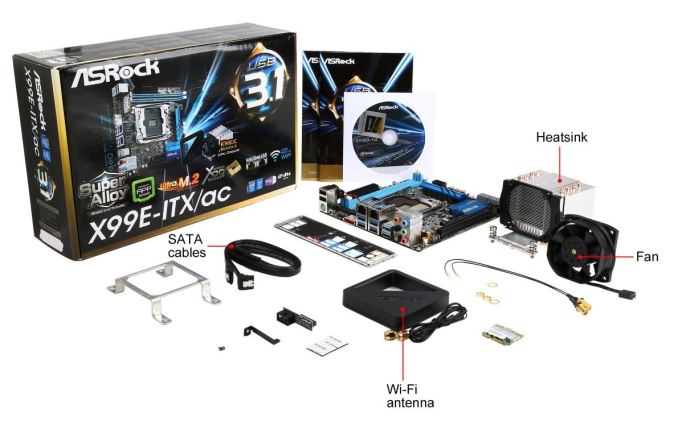The ASRock X99E-ITX/ac Review: Up to 36 Threads in Mini-ITX
by Ian Cutress on June 24, 2015 8:00 AM ESTASRock X99E-ITX/ac In The Box
With part of the focus of X99 on connectivity, and the size of the X99E-ITX limiting that connectivity, it makes it hard to judge what should exactly be in the box here. With only six SATA ports in play, we could get a full assortment of SATA cables but the inclusion of WiFi also brings in an antenna solution for users to play with. Also, by virtue of the narrow ILM socket used by the motherboard, in order to solve sourcing issues for coolers ASRock has bundled one form Dynatron in with the package, so every user should have an appropriate cooler.
In the X99E-ITX we get the following:
Driver DVD
Manuals
Rear IO Shield
Two SATA Cables
Dynatron Heatsink and Fan
Magnetic Liquid Cooler Bracket
WiFi Module and support
WiFi Antenna
Many thanks to...
We must thank the following companies for kindly providing hardware for our test bed:
Thank you to AMD for providing us with the R9 290X 4GB GPUs.
Thank you to ASUS for providing us with GTX 980 Strix GPUs and the R7 240 DDR3 GPU.
Thank you to ASRock and ASUS for providing us with some IO testing kit.
Thank you to Cooler Master for providing us with Nepton 140XL CLCs.
Thank you to Corsair for providing us with an AX1200i PSU.
Thank you to Crucial for providing us with MX200 SSDs.
Thank you to G.Skill and Corsair for providing us with memory.
Thank you to MSI for providing us with the GTX 770 Lightning GPUs.
Thank you to OCZ for providing us with PSUs.
Thank you to Rosewill for providing us with PSUs and RK-9100 keyboards.
Test Setup
| Test Setup | |
| Processor | Intel Core i7-5960X ES 8 Cores, 16 Threads, 3.0 GHz (3.5 GHz Turbo) |
| Motherboards | ASRock X99E-ITX/ac |
| Cooling | Dynatron - Included in Package |
| Power Supply | OCZ 1250W Gold ZX Series Corsair AX1200i Platinum PSU |
| Memory | Corsair DDR4-2133 C15 2x8 GB 1.2V or G.Skill Ripjaws 4 DDR4-2133 C15 2x8 GB 1.2V |
| Memory Settings | JEDEC @ 2133 |
| Video Cards | MSI GTX 770 Lightning 2GB (1150/1202 Boost) ASUS R7 240 2GB |
| Hard Drive | Crucial MX200 1TB |
| Optical Drive | LG GH22NS50 |
| Case | Open Test Bed |
| Operating System | Windows 7 64-bit SP1 |
ASRock X99E-ITX/ac Overclocking
Experience with ASRock X99E-ITX/ac
Needless to say, the X99E-ITX is not perhaps built with overclocking in mind. The only option given for automatic overclockers is 3.8 GHz in both the BIOS and the software, perhaps suggesting that ASRock feels that the small form factor systems that the motherboard is aimed at will not allow sufficient airflow. Either that or the lower mass of the narrow ILM socket also affects temperatures, or the small power delivery heatsinks might also be a limiting factor. That being said, anyone with a good cooler can still try their hand at extreme overclocking.
In our testing, the automatic overclock option actually failed at idle – the system shut off similar to an overheating system. We saw that the option actually placed the CPU at 1.200 volts, which is not very high, but there might be other factors in play here. In our manual testing, 1.200 volts actually gives a high temperature but only at load, suggesting that the automatic overclocking option actually adjusts some other factors that causes the system to fail.
Methodology
Our standard overclocking methodology is as follows. We select the automatic overclock options and test for stability with PovRay and OCCT to simulate high-end workloads. These stability tests aim to catch any immediate causes for memory or CPU errors.
For manual overclocks, based on the information gathered from previous testing, starts off at a nominal voltage and CPU multiplier, and the multiplier is increased until the stability tests are failed. The CPU voltage is increased gradually until the stability tests are passed, and the process repeated until the motherboard reduces the multiplier automatically (due to safety protocol) or the CPU temperature reaches a stupidly high level (100ºC+). Our test bed is not in a case, which should push overclocks higher with fresher (cooler) air.












56 Comments
View All Comments
Samus - Thursday, June 25, 2015 - link
I've had poor experience with every SLI setup I've built. The performance per dollar just isn't there for gaming.Pork@III - Thursday, June 25, 2015 - link
X99 on ITX is capitalism perverse!BlueTortoise - Thursday, June 25, 2015 - link
Are there any plans to test the ASRock Rack EPC612D4I?It'd be interesting to see what the real-life performance difference between this board and the EPC612D4I, given the latter has four SODIMM slots, enabling quad channel memory.
creed3020 - Monday, June 29, 2015 - link
For review of that board head over here: http://www.servethehome.com/asrock-rack-epc612d4i-...Beaver M. - Monday, June 29, 2015 - link
That is one of the worst designs I have ever seen. I dont get it. The same is happening with the Z170E-ITX it seems. They had a perfect CPU socket placement on the old ones and were highly praised by everyone for it, since it fit so well in small cases, and now they move it down all of the sudden.WHY ASROCK WHY?
MySchizoBuddy - Tuesday, June 30, 2015 - link
Why didn't you do any cpu opencl bechmarks. this would be very good for a compute unit